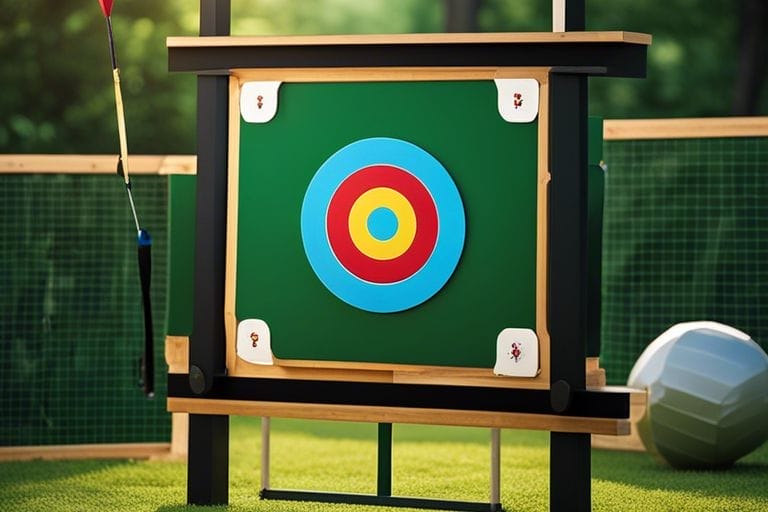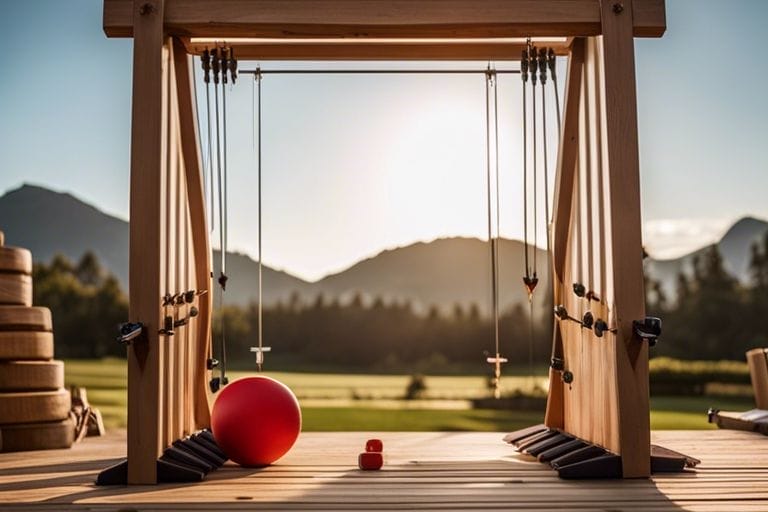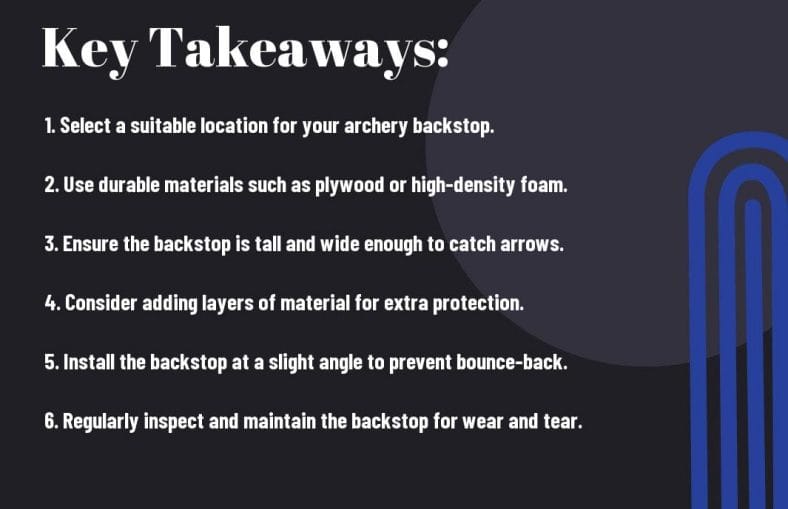When you indulge in the skillful art of archery, safety and precision are of utmost importance. A well-constructed backstop not only ensures the safety of both you and your surroundings, but it also helps to preserve your arrows and bows for a longer period of time. In this blog post, we will guide you through the process of making your own archery backstop, offering you a cost-effective and personalized solution to your archery needs. Whether you are a beginner or a seasoned archer, having a reliable backstop is essential for honing your skills and keeping the environment safe. So, let’s get started on creating your very own archery backstop.
Key Takeaways:
- Choose the right materials: When making an archery backstop, it is important to use a durable and robust material that can withstand the force of the arrows. Options include heavy-duty netting, hay bales, or a dense foam target.
- Construct a sturdy frame: Building a strong and stable frame for the backstop is essential for safety and effectiveness. Use strong and sturdy materials such as PVC pipes or lumber to create a frame that can securely hold the backstop material in place.
- Ensure proper setup: Proper setup of the archery backstop is crucial for its effectiveness. Position the backstop at a suitable distance from the target area and ensure that it is securely anchored to prevent any potential movement or collapse during use.
Choosing the Right Location
When setting up your archery backstop, the location is key to ensuring safety and optimal performance. Some key factors to consider when choosing the right location for your backstop include the surrounding environment, the proximity to other structures or people, and the space available for shooting.
Safety Considerations
Before you set up your archery backstop, it’s crucial to consider the safety of everyone in the vicinity. You must ensure that the backstop is placed in an area where there is no risk of shooting towards people, animals, or buildings. Additionally, make sure that the backstop is positioned in a way that prevents arrows from ricocheting and causing harm.
Space Requirements
When determining the location for your archery backstop, you need to consider the space required for shooting safely. Ideally, the area should allow you to shoot from a reasonable distance without any obstructions. You will also need enough space to retrieve arrows easily without hindrance.

Backstop Materials and Construction
Any archery backstop you make will require a solid structure to safely absorb and stop arrows. For a step-by-step guide on how to make an archery backstop, check out this Make An Archery Backstop, Step By Step Guide for detailed instructions.
Hay Bales and Foam Layers
When constructing a backstop, using hay bales and foam layers can provide an effective and affordable solution. You can stack hay bales to form a sturdy wall, and layer foam padding on the front to help slow down and stop arrows. This method is relatively easy to set up and can be a great option for home archery ranges.
Wooden Backstop Options
If you prefer a more permanent backstop solution, constructing a wooden frame with materials such as plywood and 2x4s can provide a durable and long-lasting structure. You can then attach foam layers or use other materials to create a safe surface for arrow impact. Wooden backstops are ideal for outdoor archery setups and can be customized to fit the specific dimensions of your range.
Commercial Backstop Solutions
If you’re looking for a convenient and ready-made option, there are commercial backstop solutions available for purchase. These may include portable netting systems, archery range curtains, or other specialized backstop products designed for different types of archery practice. While these solutions may come at a higher cost, they can provide a professional and reliable way to set up a safe backstop for your archery range.

Building the Backstop
Your archery backstop is an essential element of your setup. It provides a safe and secure area for your arrows to land, preventing any potential damage to property or injury to bystanders. Building your own backstop is a cost-effective and customizable solution. Here’s how you can get started.
Step-by-Step Assembly Instructions
When building your backstop, it’s important to follow a step-by-step process to ensure its stability and effectiveness. Here are the key assembly instructions:
| Step 1: | Choose a suitable location for your backstop, ensuring it’s away from any potential obstructions or hazards. |
| Step 2: | Construct a frame using sturdy materials such as wood or PVC piping, ensuring it is tall enough to catch any stray arrows. |
| Step 3: | Attach a suitable backstop material such as heavy-duty canvas, ballistic nylon, or layered foam to the frame, creating a secure barrier for your arrows to hit. |
Mounting and Securing the Backstop
Once your backstop is constructed, it’s crucial to mount and secure it properly to ensure it remains stable during use. You can do this by:
1. Attaching the backstop to a sturdy base or anchoring it securely to the ground to prevent any movement or tipping.
2. Checking the backstop regularly for any signs of wear and tear, and making necessary repairs or replacements to maintain its effectiveness.
Maintenance and Upkeep
Unlike other sports equipment, archery backstops require regular maintenance and upkeep to ensure their effectiveness and longevity. By following a proper maintenance schedule and implementing weatherproofing techniques, you can extend the lifespan of your backstop and maintain its functionality for years to come.
Inspection and Repair Schedule
Regular inspection of your archery backstop is crucial to identify any damage or wear and tear. Set a schedule to thoroughly inspect the backstop at least once a month. Look for any holes, tears, or weakening of the material. It is important to promptly repair any damage, as neglecting small issues can lead to larger, more expensive problems down the line. Keep a record of your inspections and repairs to track the condition of your backstop over time.
Tips for Longevity and Weatherproofing
To maintain the longevity of your archery backstop, it’s important to take steps to protect it from the elements. Apply a weatherproofing sealant to the material to prevent water damage and prolong its lifespan. Additionally, store your backstop in a dry, cool area when not in use to prevent exposure to harsh weather conditions. Assume that proper weatherproofing and storage will extend the life of your backstop and save you money in the long run.
- Apply a weatherproofing sealant to the backstop material
- Store the backstop in a dry, cool area when not in use

Conclusively, Making Your Own Archery Backstop is Achievable
By following these steps, you can successfully create your own archery backstop in a cost-effective and efficient manner. Remember to choose suitable materials, construct a sturdy frame, and always ensure the safety of your shooting environment. With the right tools and dedication, you can tailor your backstop to fit your specific needs and enjoy the convenience of practicing archery at home. By taking the time to craft a high-quality backstop, you’ll be able to enhance your archery experience and improve your skills with peace of mind.
FAQ
Q: What materials are needed to make an archery backstop?
A: To make an archery backstop, you will need a suitable target material such as high-density foam or layered cardboard, a sturdy frame to hold the target material in place, and a backstop netting or curtain to catch stray arrows.
Q: How should the archery backstop be constructed?
A: The target material should be securely affixed to the frame, ensuring that there are no gaps or areas where arrows could pass through. The backstop netting or curtain should be positioned several feet behind the target to effectively catch any arrows that miss the mark.
Q: What safety precautions should be taken when using an archery backstop?
A: It is essential to establish a designated shooting area with clear boundaries and proper supervision. All archers should be trained in proper shooting techniques and be required to adhere to strict safety protocols. Additionally, regular inspection and maintenance of the backstop and surrounding area are crucial to ensure a safe and effective archery experience.


